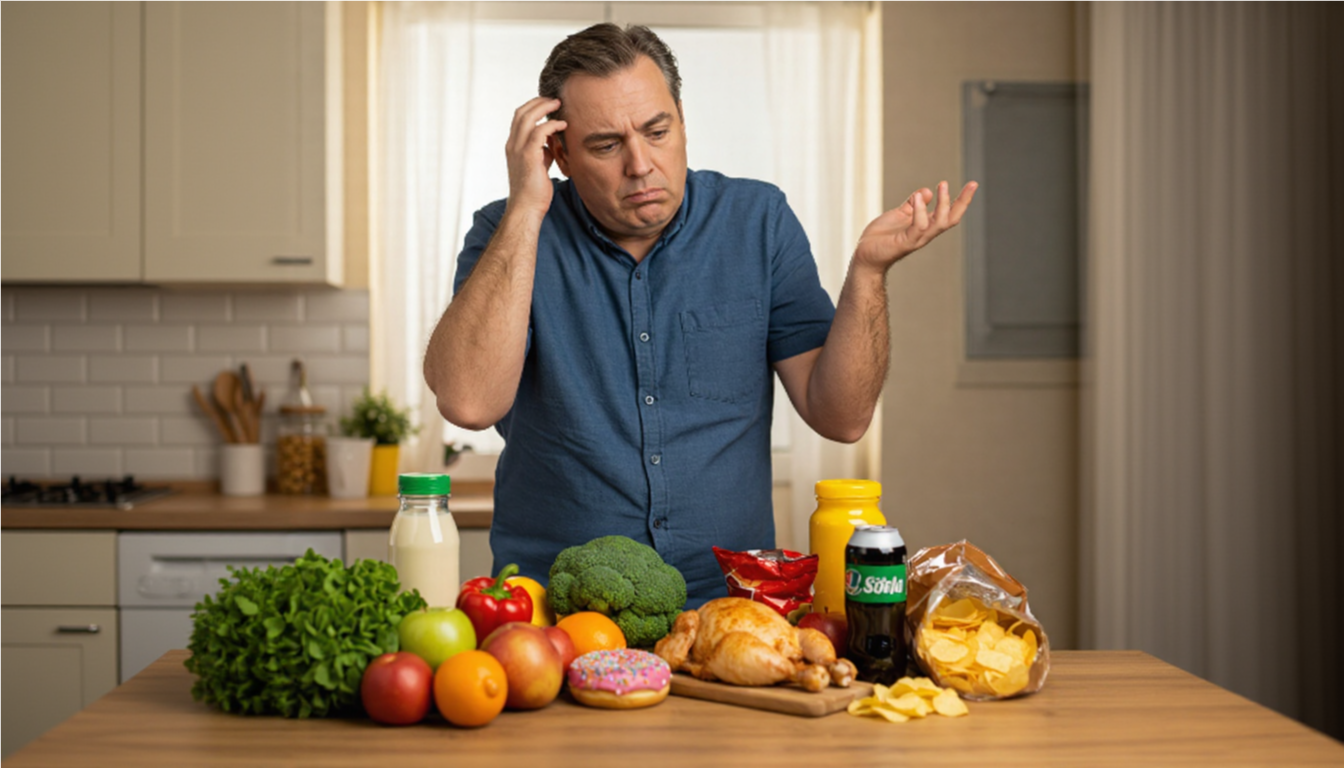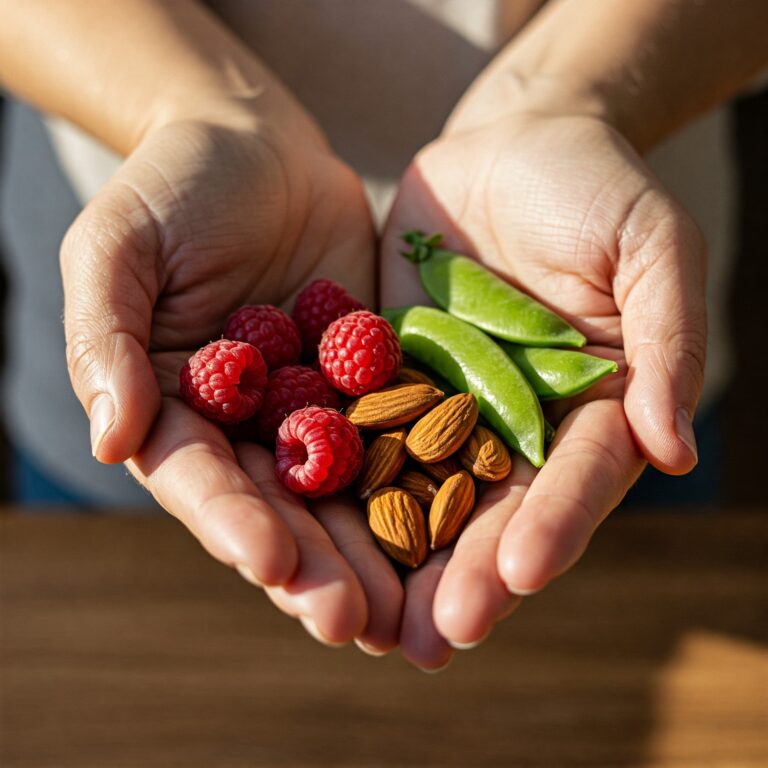From Your Plate to Your Waistline: How We Actually Gain Fat
“Man, nutrition. It’s a maze, isn’t it? Seems like everyone’s pushing their own idea, and there you are, just trying to decide what to even cook for dinner. Most of us are probably just silently screaming, “Seriously, what AM I supposed to eat?!” And why does weight creep on anyway – what’s the actual deal with how your body stores fat?” Then, bam! The advice avalanche hits. “You’re eating too much!” No, wait, “Fats are evil!” Hold on, “Carbs are the real villain!” And don’t even get me started on sugar – “Definitely cut that out!” It’s enough to make you want to just, I don’t know, give up and ask, “Who on earth do I believe anymore?!”
All this confusion? Yeah, it’s enough to make you just want to throw your hands in the air and go, “You know what? I’m just sticking with what I know and crossing my fingers!” But let’s be real, that ‘cross your fingers and hope’ plan? It rarely ends up giving us the results we’re looking for.
The good news is, understanding how our bodies work, especially how they store fat, isn’t about finger-pointing. It’s about getting some clarity. Our bodies are actually pretty smart. They’re built to save energy for later, and storing fat is a key way they do this. It’s a survival mechanism, not a flaw.
So, let’s walk through what happens to food from the moment it passes your lips to how it might end up as stored energy. Hopefully, this will answer more questions than it creates!
The First Stops: Chewing and Your Tummy
It all begins with that first bite. Your teeth get to work, breaking food into smaller bits. Saliva joins in, starting the breakdown process. Then, food journeys down to your stomach. Here, stomach acids and enzymes continue the job, turning your meal into a more broken-down mixture.
Here’s a simple breakdown:
- Carbohydrates (think bread, pasta, fruit) begin their transformation into sugars. Glucose is the main one.
- Fats (from oils, butter, nuts) start to separate into smaller parts called fatty acids and glycerol.
- Proteins (found in meat, beans, eggs) start unraveling into their building blocks, amino acids.
These smaller components are now getting ready for the next big step.
Into the Bloodstream: Absorption Power
From your stomach, this pulpy mix heads into your small intestine. This is where the main event of absorption happens. The lining of your small intestine is covered in tiny, finger-like projections called villi. Their job is to grab those sugars, fatty acids, glycerol, and amino acids. These nutrients then pass through the intestinal wall and enter your bloodstream.
Now, these bits of energy are circulating throughout your body. They’re available to fuel your cells. Or, if there’s more than needed right away, they’re tagged for storage.
The Energy Guide: Hello, Insulin!
Okay, picture this: sugar, mainly glucose, enters your blood. Boom! That’s like a tiny alarm bell for your pancreas. So, what does your pancreas do? It quickly sends out insulin – that’s a hormone. And insulin? It’s a pretty big deal. It’s basically the key master, you know? It unlocks your cells so all that glucose can get in and do its job.
Insulin signals your cells to take in glucose from the blood. Your cells can use this glucose for immediate energy. If your cells have all the energy they need for the moment, insulin then helps guide the extra glucose into storage.
The first place extra glucose goes is into your liver and muscles. Here, it’s stored as something called glycogen. Now, if you’ve ever heard the term “glycogen” and wondered, “What is that? Where does it come from?” – you’re not alone! It used to sound like some mysterious code to me too. Think of glycogen simply as your body’s readily available, quick-access sugar reserve. But, these glycogen “pantries” are not huge. They can fill up quickly.
Glycogen Full? How Your Body Stores Fat From Excess Carbs
So, what happens when these glycogen stores are topped up, but there’s still more glucose from the carbs you ate than your body needs for current energy demands? This is where your liver performs a process called de novo lipogenesis. This scientific term, with Latin roots, simply means your body is “making new fat” from non-fat starting materials – in this case, from those excess carbohydrates.
Your liver takes this surplus glucose. It converts it into a type of fat called triglycerides. Imagine a factory line changing one raw material into a completely different product. It’s a normal, efficient bodily process designed to ensure no potential energy goes to waste.
So, get this: even if your meal itself isn’t packed with fat, if you eat way more carbs than your body needs for energy right away, or more than it can tuck away for later, your body can take those extra carbs and turn them into fat. Seriously!
What About the Fats You Eat?
The fats you consume in your diet also get broken down into fatty acids and glycerol, as we mentioned. These are absorbed into your bloodstream as well. They are an excellent source of energy. They are also vital for building cell membranes and for many other important bodily functions.
But what if you eat more fat than your body needs for these immediate tasks? Well, dietary fats are particularly easy for your body to store. They don’t require much additional processing. They can be readily repackaged into triglycerides. Then, they are sent off to be stored in your fat cells.
You could say dietary fat is like having ready-to-use materials delivered to a storage facility. Your body can tuck them away very efficiently. Converting carbs to fat is more like having to manufacture those storage materials first. Either way, if there’s an excess, it leads to fat storage.
And Protein?
So, what’s protein really for? Think of it as the body’s main construction crew. Its biggest job is to build and fix things – like your muscles, organs, skin, all that stuff. Now, while it can be used for energy, it’s not really the body’s go-to fuel if there are carbs and fats on hand.
So, imagine you’re eating way more protein than your body needs for all its building and fixing jobs. What happens to the extra? Well, some of that leftover protein can get turned into a type of sugar called glucose. Now, if your body doesn’t use that glucose for energy quickly, there’s a chance – just a chance, mind you – it could end up being stored as fat. However, this is a much less direct and less efficient route for the body to make fat compared to how it handles excess carbs or dietary fats.
The Storage Units: Your Fat Cells (Adipose Tissue)
So, where do these triglycerides – whether they’re newly made from carbs or came directly from dietary fats – actually go? They travel through your bloodstream. They are looking for a place to settle. This primary storage location is your adipose tissue, which we commonly know as body fat.
Adipose tissue is composed of fat cells, also called adipocytes. Picture these cells as tiny, flexible storage tanks. When triglycerides arrive, these fat cells take them in. As they fill up, the cells expand. This is essentially how fat accumulates in your body.
These fat cells are located under your skin (this is called subcutaneous fat). They are also found around your internal organs (known as visceral fat).
Your body is quite resourceful. It stores this fat for a very practical reason: to have an energy reserve for times when food might be scarce, or when you need a lot of energy for intense physical activity.
So, How Do We Gain Fat? It’s About Energy Balance.
Gaining fat isn’t solely about how much fat you eat. It’s more accurately about consuming more total energy (calories) than your body uses up. This surplus energy can come from carbohydrates, fats, or, to a lesser extent, even excess protein. Carbs and fats are usually the main contributors.
When you take in more energy than you burn:
- Food is digested. Nutrients like glucose and fatty acids enter your blood.
- Insulin helps cells use glucose for immediate energy and then directs the surplus for storage.
- Extra glucose is stored as glycogen until those limited stores are full.
- Once glycogen stores are at capacity, the liver can convert further excess glucose into triglycerides (fat).
- Dietary fats not used for immediate energy are easily converted into triglycerides.
- These triglycerides are then stored in your fat cells (adipose tissue), causing them to expand.
It’s a natural and quite intricate system. Your body is simply trying to be efficient by saving any extra fuel “just in case.” Getting a handle on this process can really help move past that “whatever” feeling. It puts you in a much better position to make informed choices about eating in a way that supports your health and well-being. Finally understanding how it works can be a big relief!
References used:
https://pmc.ncbi.nlm.nih.gov
https://pubmed.ncbi.nlm.nih.gov
https://www.niddk.nih.gov



